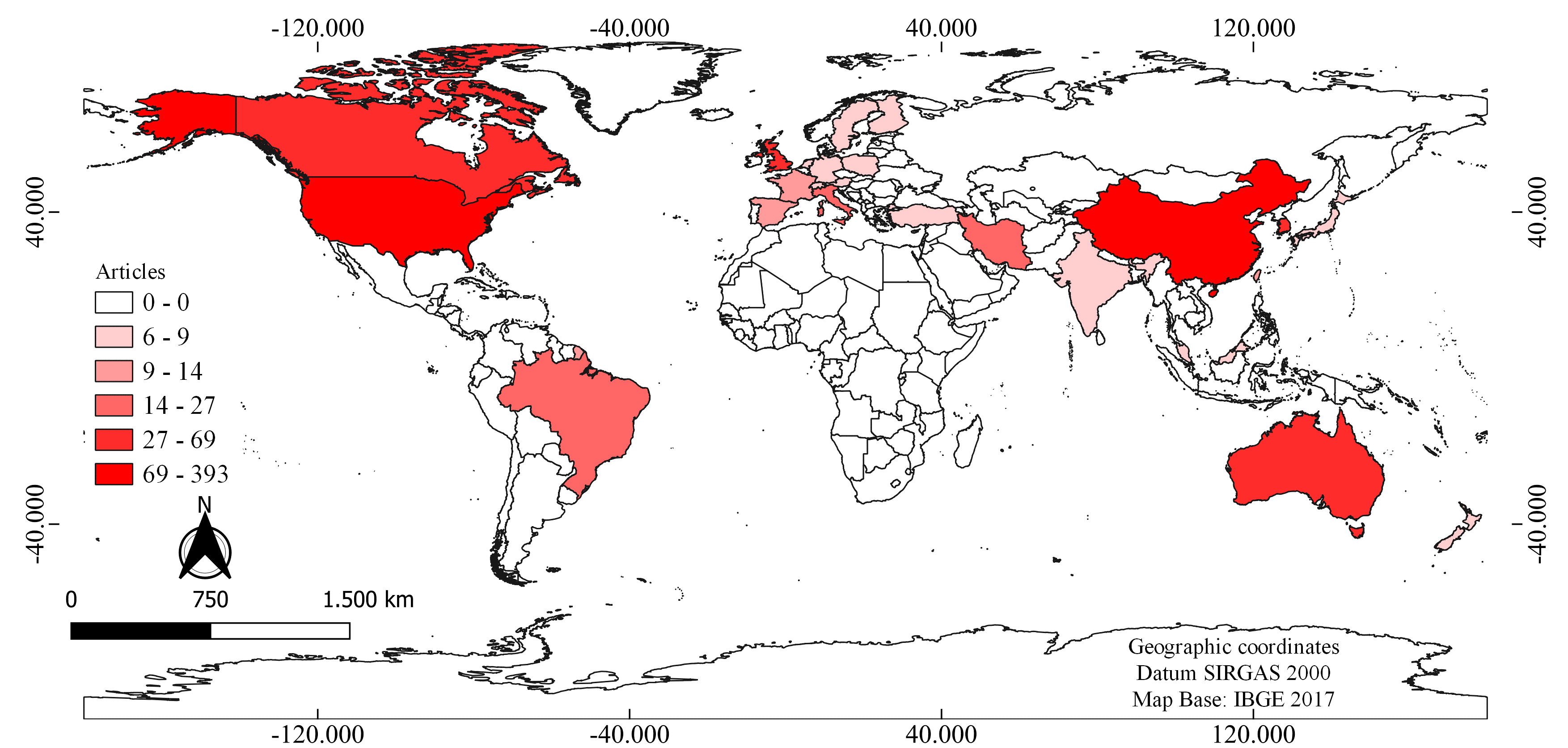Abstract
The management of drainage and urban rainwater management in Brazil and in the world faces numerous challenges in order to be sustainable. When dealing with sustainability, it is important to relate the aspects: of social, environmental and economic, known as the sustainability tripod. Compensatory urban drainage techniques, through infiltration or detention and increasing the evapotranspiration rate, have the potential to reduce: the amount of rainwater runoff; flow peaks; vulnerability of urban areas to flooding; contamination of water courses. It is important that, even with all these benefits, such technologies are associated with such aspects. In this context, this systematic review article (SR) was developed, which aimed to identify trends in the use of sustainable drainage technologies adopted in Brazil and in the world, relating them to aspects of sustainability. For that, a systematic review (SR) was carried out in which the following were identified: trends in the adoption of technologies for sustainable drainage in the world and in Brazil; and the terms used and related to technologies for sustainable drainage. It was also observed, both in Brazil and in the world, that the approach to the theme begins with the technological aspect involving the implementation, life cycle and maintenance of sustainable technologies and, in sequence, the environmental, economic and social aspects unfold in this order, but which are not done in an integral way. It was possible to characterize an important knowledge gap.
References
ALAMY FILHO, J. E. et al. Eficiência hidrológica de telhados verdes para a escala de loteamentos residenciais. Sociedade & NaturezaUberlândia, v. 28, n. 2, 2016. https://doi.org/10.1590/1982-451320160206
BRASIL. Lei nº. 14.026: Atualiza o marco legal do saneamento básico e dá outras providências. Diário Oficial [da] República Federativa do Brasil. Brasília, DF, 2020.
BRASS, I.; PELCZARSKI, F.; SAGE, H. Catalyst for Improving the Environment Evaluation Report Source Water Assessment and Protection Programs Show Initial Promise, But Obstacles Remain. Office of Inspector General, 2005.
BROWN, H. L. et al. More than money: how multiple factors influence householder participation in at-source stormwater management. Journal of Environmental Planning and Management, v. 59, n. 1, p. 79–97, 2016. https://doi.org/10.1080/09640568.2014.984017
CHANG, C. et al. Sustainability. Water Environmentt Research, v. 86, n. 10: 1354–1386, 2014. https://doi.org/10.2175/106143014X14031280667895
FARIAS, A.; MENDONÇA, F. Riscos socioambientais de inundação urbana sob a perspectiva do Sistema Ambiental Urbano. Sociedade & Natureza, Uberlândia, v. 34, n. 1, 2022. : https://doi.org/10.14393/SN-v34-2022-63717
FLETCHER, T. D. et al. SUDS, LID, BMPs, WSUD and more – The evolution and application of terminology surrounding urban drainage. Urban Water Journal, v. 12, n. 7: p. 525–542, 2015. https://doi.org/10.1080/1573062X.2014.916314
GUERRA, A. J. T.: CUNHA, S. B. (Org.). Geomorfologia: Uma Atualização de Bases e Conceitos. 164. ed. Rio de Janeiro: Bertrand Brasil, 2022. 472p.
GONÇALVES, L. M; BAPTISTA, L. F. S; RIBEIRO, R. A. O uso de técnicas compensatórias de drenagem para controle dos impactos a urbanização. In: OTTONI, A. B.; ROSIN, J. A. R. G.; FOLONI, F. M. (Org.). Drenagem urbana: soluções alternativas sustentáveis. 11-29. 1. ed. Tupã, São Paulo, Brazil: ANAP, 2018.
JIA, H. et al. China’s sponge city construction: A discussion on technical approaches. Frontiers of Environmental Science and Engineering, v. 11, n. 4: 1–11, 2017. https://doi.org/10.1007/s11783-017-0984-9
LI, H.; et al. Sponge city construction in China: A survey of the challenges and opportunities. Water (Switzerland), v. 9, n. 9: 1–17, 2017. https://doi.org/10.3390/w9090594
LIU, Y.; BRALTS, V. F.; ENGEL, B. A. Evaluating the effectiveness of management practices on hydrology and water quality at watershed scale with a rainfall-runoff model. Science of the Total Environment, v. 511, n. February: 298–308, 2015. https://doi.org/10.1016/j.scitotenv.2014.12.077
MONTALTO, F. et al. Rapid assessment of the cost-effectiveness of low impact development for CSO control. Landscape and Urban Planning, v. 82, n. 3: 117–131, 2007. https://doi.org/10.1016/j.landurbplan.2007.02.004
OLIVEIRA, A. P.; BARBASSA, A. P.; GONÇALVES, L. M. Aplicação de técnicas compensatórias de drenagem na requalificação de áreas verdes urbanas em Guarulhos-SP. Periódico Técnico e Científico Cidades Verdes, v. 8, n. 9: 87-101, 2016. https://doi.org/10.17271/231786044920161385
PAGE, M. J. et al. The PRISMA 2020 statement: an updated guideline for reporting systematic reviews. International Journal of Surgery, 88: 10-89, 2021.
ROSA, A. et al. Sustainable urban drainage: delineation of a scientific domain of knowledge production. Revista Tecnologia e Sociedade, v. 15, n. 38: 18–36, 2019. https://doi.org/10.3895/rts.v15n38.9017
SANTOS, S. A. et al. Qualidade da água na bacia hidrográfica urbana Cancela Tamandaí, Santa Maria/RS. Sociedade & Natureza, Uberlândia, v. 30, n. 2, 2018. http://dx.doi.org/10.14393/SN-v30n2-2018-2-X
SHUSTER, W.; RHEA, L. Catchment-scale hydrologic implications of parcel-level stormwater management (Ohio USA). Journal of Hydrology, 485: 177–187, 2013. https://doi.org/10.1016/j.jhydrol.2012.10.043
SNIS - SISTEMA NACIONAL DE INFORMAÇÕES SOBRE SANEAMENTO. Diagnóstico de Drenagem e Manejo de Águas Pluviais Urbanas. 2019. Available: http://www.snis.gov.br/. Access on: Aug. 02, 2021.
TASCA, F. A. Simulação de uma Taxa para Manutenção e Operação de Drenagem Urbana para Municípios de Pequeno Porte. 161 f. Dissertation (Master in Environmental Engineering), Universidade Federal de Santa Catarina, 2016.
TASCA, F. A; ASSUNÇÃO, L. B; FINOTTI, A. R. International experiences in stormwater fee. Water Science &Technology, Bonus Issue 1: 287-299, 2018. https://doi.org/10.2166/wst.2018.112
TAYLOR, A. C.; FLETCHER, T. D. Nonstructural urban stormwater quality measures: Building a knowledge base to improve their use. Environmental Management, v. 39, n. 5: 663–677, 2007. https://doi.org/10.1007/s00267-005-0398-5
WANG, Y.; SUN, M.; SONG, B. Public perceptions of and willingness to pay for sponge city initiatives in China. Resources, Conservation and Recycling, 122: 11–20, 2017. https://doi.org/10.1016/j.resconrec.2017.02.002
WEB OF SCIENCE. Graph for terms: “regulatory taxation” OR “immovable property take” OR “municipal taxation” OR “drainage tax” OR “water charges” AND “stormwater drainage” AND “sustainable drainage” OR “low impact development”. Available: http:// https://www.webofscience.com/. Access on: Jul. 15, 2020.

This work is licensed under a Creative Commons Attribution 4.0 International License.
Copyright (c) 2022 Ana Paula Camargo de Vicente, Karla Maria Silva Faria, Klebber Teodomiro Martins Formiga

